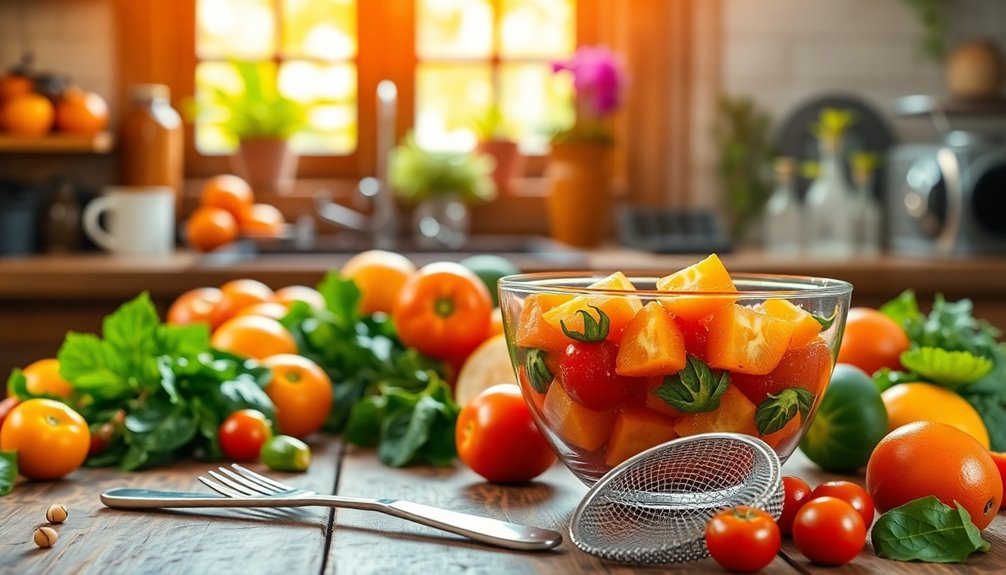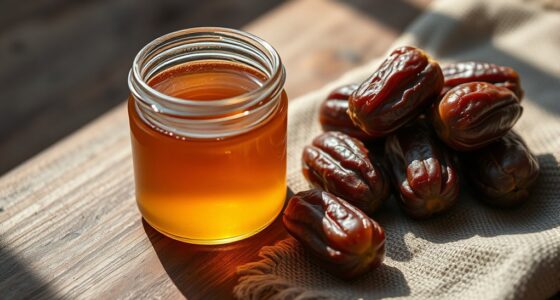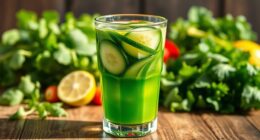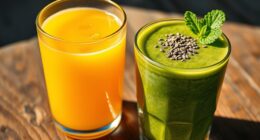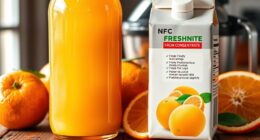No juicer? No problem! You can make delicious juices using a blender and some simple tools. Start by choosing sweet fruits, nutrient-rich veggies, and fresh herbs that you love. After washing and prepping your ingredients, blend them until smooth. Then strain the mixture using a nut milk bag or cheesecloth for a refreshing juice free of pulp. Juicing at home is not only fun but also packed with health benefits, and there's plenty more to explore!
Key Takeaways
- Use a high-speed blender or NutriBullet to blend fruits and vegetables into a smooth base for your juice.
- Strain the blended mixture using a nut milk bag or cheesecloth to separate the juice from the pulp.
- Choose sweet fruits, nutrient-rich vegetables, and herbs for a delicious and healthy juice blend.
- Prepare ingredients by washing, chopping, and storing them in airtight containers for easy access.
- Experiment with blending times and techniques to achieve your desired juice texture and flavor.
Essential Tools for Juicing Without a Juicer
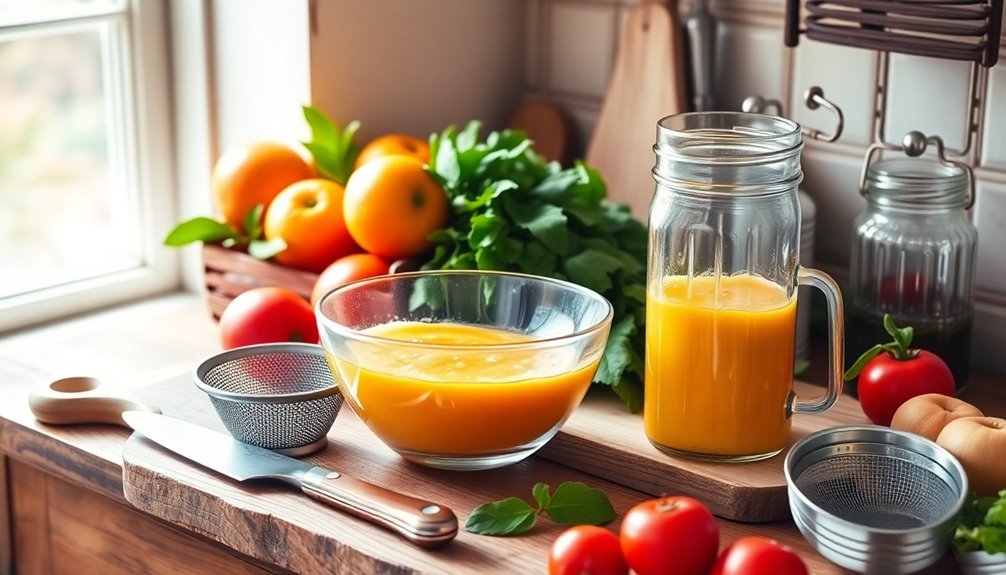
When you want to enjoy fresh juice without a juicer, having the right tools can make all the difference.
Start with a high-speed blender or a standard blender to create a smooth base. If you're looking for convenience, a NutriBullet works wonders for quick blends. Strained juice can be enjoyed immediately after preparation, ensuring you get the freshest taste possible. Drinking juice in the morning is ideal for maximum benefits to your health.
After blending, you’ll need straining tools like a nut milk bag or cheesecloth to separate the juice from the pulp effectively. A fine mesh strainer or colander can help with larger quantities. To make the straining process even more efficient, consider using a juice groove jig tutorial that outlines techniques for maximizing extraction. This can help you achieve a smoother consistency and reduce waste from the pulp. Once you’ve separated the juice, you can enjoy it fresh or store it in an airtight container for later use.
For storage, glass jars and airtight containers keep your juice fresh, while a thermos lets you take it on the go.
Don't forget a spatula for scraping, measuring cups for accuracy, and a ladle for serving.
Enjoy your DIY juicing!
Choosing the Right Ingredients for Your Juice
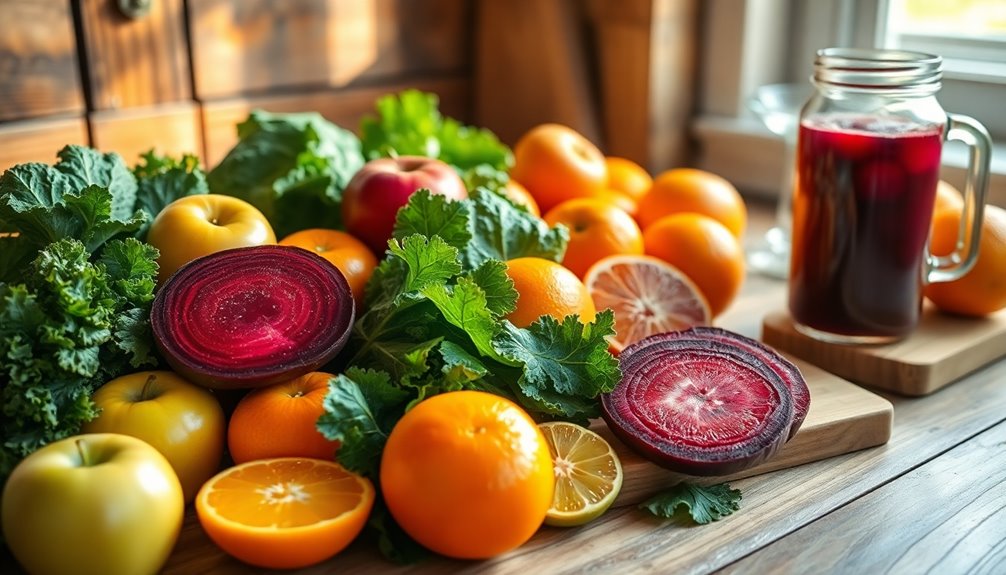
Selecting the right ingredients for your juice can significantly enhance both its flavor and nutritional value. Start with fruits like apples and pineapples for sweetness and essential vitamins. Berries are a great addition, providing antioxidants and supporting healthy blood sugar levels. Additionally, using a blender and nut bag instead of a traditional juicer allows for a quick and straightforward juice preparation process.
For vegetables, kale and carrots are nutrient-rich options that boost immune health and vision. Incorporating educational toys can also encourage children to develop healthy eating habits through imaginative play. Celery adds crunch and potassium, while beetroot supports your heart and athletic performance.
Incorporating herbs like ginger and mint can elevate flavor and aid digestion. Using seasonal produce ensures optimal taste and nutrition, making your juice both delicious and healthy.
Step-by-Step Guide to Preparing Your Ingredients
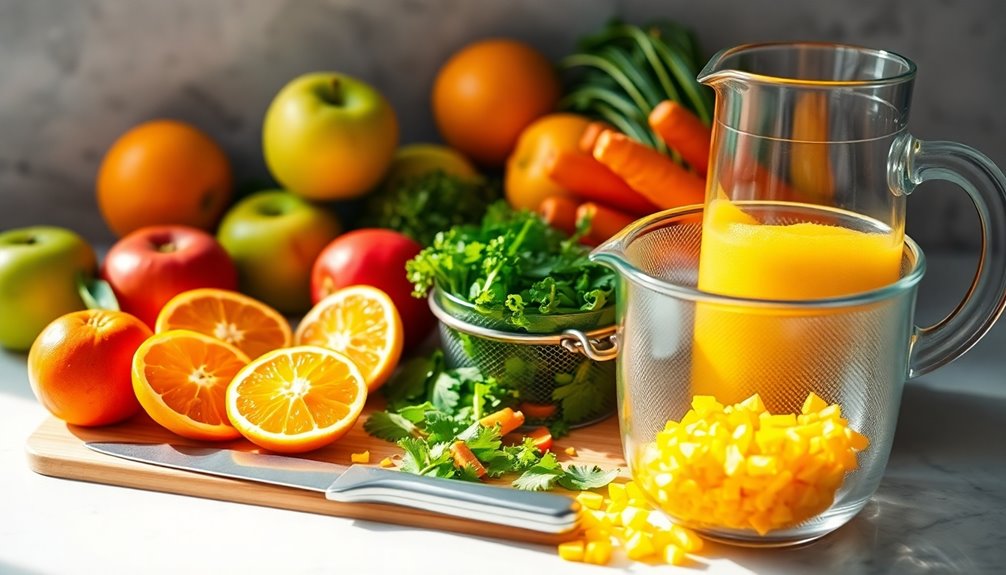
Preparing your ingredients for juicing without a juicer can be simple and efficient if you follow a few key steps.
Start by washing all produce thoroughly to remove dirt and pesticides. Remove seeds and pits to prevent bitterness, and peel citrus fruits for smoother blending. Additionally, consider using a combination of sweet, tart, earthy, and herbaceous ingredients to enhance the flavor profile of your juice. For instance, beet juice is known for its health benefits, including improved blood circulation.
Chop ingredients into medium-sized chunks, ensuring they're roughly the same size for uniform blending. Don't forget to cut harder items like carrots into smaller pieces.
Remove any thick skins, tough parts, or moldy sections to maintain freshness. Organize your ingredients by type for easier access, and keep them cold to preserve nutrients.
If you're not using them right away, store prepared ingredients in airtight containers and label them for easy identification.
Blending Techniques for Maximum Juice Extraction
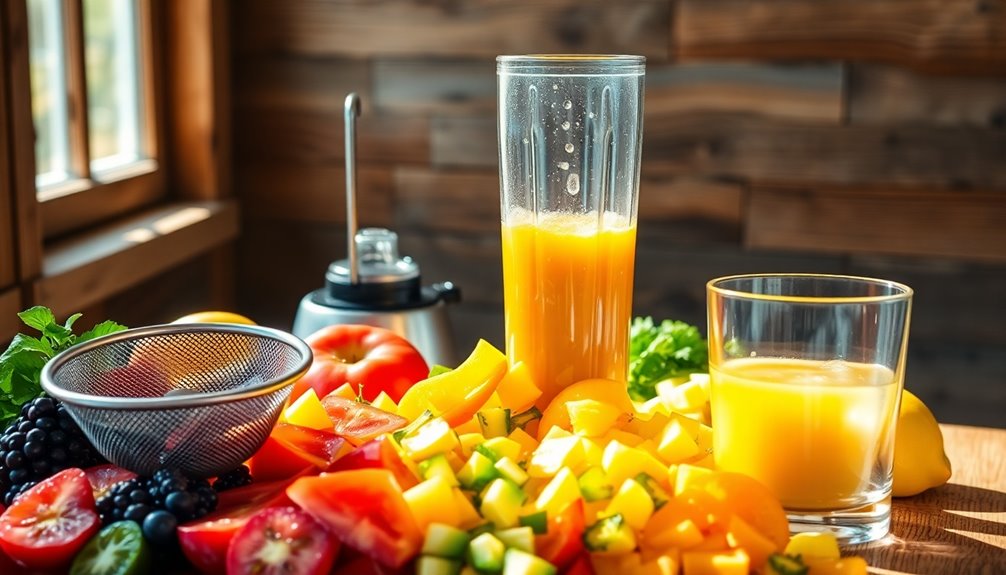
After you've chopped and organized your fruits and vegetables, it's time to focus on blending techniques that maximize juice extraction.
Start with a high-speed blender or a vacuum blender to minimize oxidation and retain nutrients. Blend your ingredients for about 30 seconds to a minute, but be cautious—longer blending times can generate heat, reducing beneficial compounds. Blending retains all fiber, which offers digestive benefits and contributes to overall health. Additionally, incorporating chia seeds' high fiber content into your blended juice can enhance its health benefits.
If your mix is too thick, adding a small amount of water can help achieve a smoother consistency. Remember, blended juices will be thicker due to the retained fiber, which offers digestive benefits.
Managing the pulp effectively is key to getting the most juice yield. Experiment with different blending times and techniques to find what works best for your desired juice texture and flavor.
How to Strain Your Juice Effectively
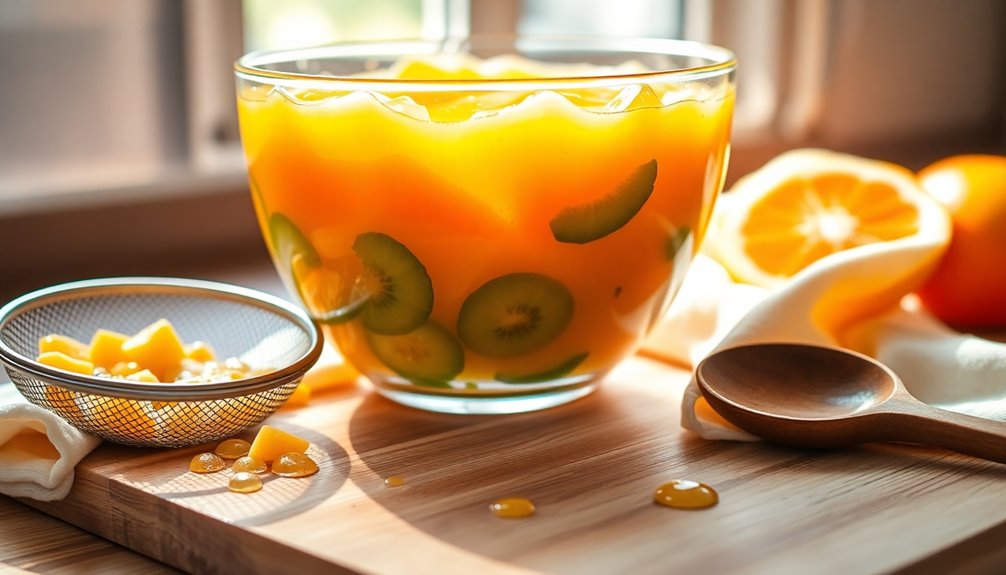
To get the most out of your blended fruits and vegetables, effective straining is essential.
Start by selecting the right straining tool—paint strainer bags work wonders for large batches, while fine-mesh sieves are perfect for citrus juices. Cheesecloth can ensure a clear liquid, and nut milk bags are great for cold-press style juicing. To enhance your juice extraction, consider using a fine mesh strainer as it allows for optimal separation of juice from pulp. Additionally, using a strainer can help you retain the nutritional advantages that come from the fruits and vegetables you are juicing.
Strain your juice immediately after blending to prevent pulp from settling. Use a large bowl to catch the juice efficiently, and squeeze gently to extract more without pushing pulp through.
Remember to clean your strainers regularly to maintain hygiene, and consider chilling them to preserve nutrients. Avoid over-squeezing and using the wrong tools to achieve the best texture and flavor.
Flavor Combinations to Try for Delicious Juices
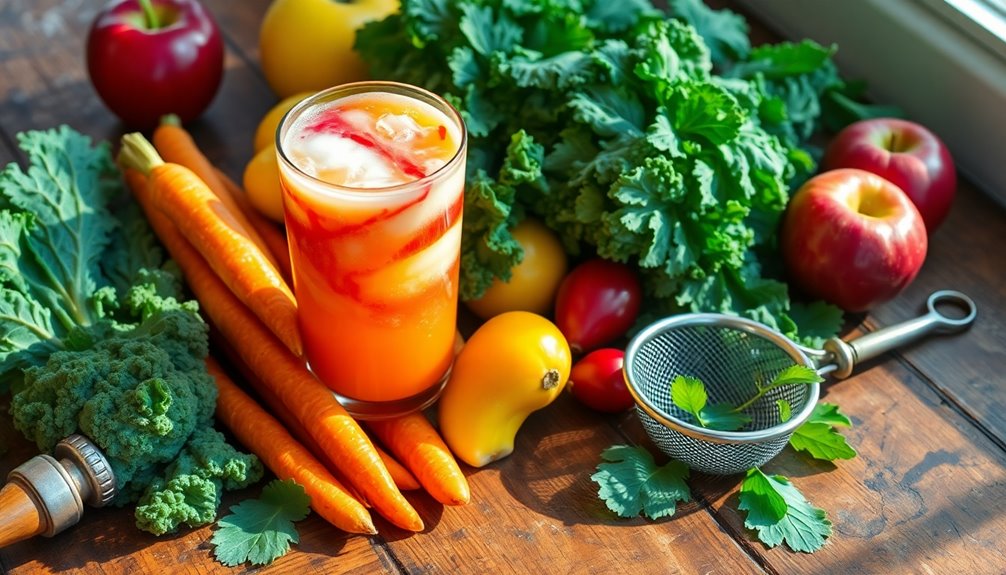
When you explore the world of juicing, discovering delicious flavor combinations can elevate your drinks to new heights. Start with sweet fruits like apples or oranges, then add tart elements like lemon or lime to balance the sweetness. For a refreshing green juice, mix kale, cucumber, pineapple, and lemon for a hydrating twist. If you prefer something earthy, try beet, apple, celery, and lemon for a tangy kick. Vegetables offer more vitamins and don't forget herbaceous flavors! A hint of basil or mint can brighten your blend. Proper storage can also ensure that your ingredients stay fresh for longer. Remember to experiment with ratios, balancing sweet and tart while avoiding overpowering ingredients. Use high-yield options like cucumbers to maximize juice output, and let your creativity flow!
Health Benefits of Juicing at Home
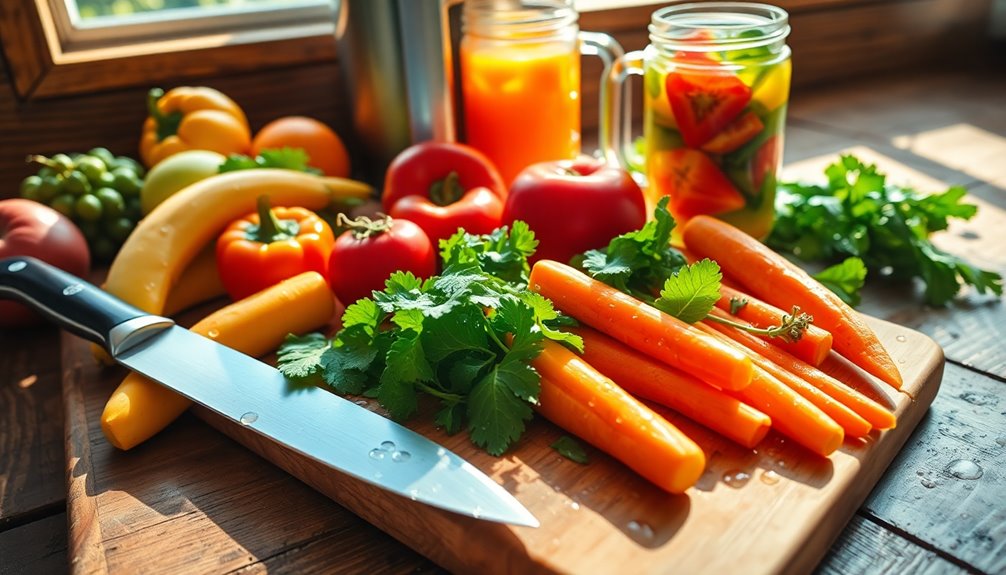
Juicing at home offers a fantastic way to boost your health, especially since you can customize your drinks to meet your nutritional needs. By juicing, you enjoy quick nutrient absorption, allowing your body to access essential vitamins and minerals without the fiber barrier. Freshly made juices retain active enzymes that aid digestion, enhancing nutrient uptake. Additionally, nutrient content can vary based on the fruits and vegetables used for juicing, so selecting a variety of produce can maximize health benefits. For instance, incorporating unique homemade fruit juice recipes can introduce new flavors and nutrients to your diet. You can also increase nitric oxide levels, promoting better blood vessel health and circulation. Plus, the antioxidants in your homemade juices help combat oxidative stress and inflammation. Juicing can even provide a quick energy boost and support weight management, making it easier to maintain a healthy lifestyle.
Frequently Asked Questions
Can I Juice Frozen Fruits and Vegetables?
Yes, you can juice frozen fruits and vegetables! Just thaw them first to break down the cell walls, making it easier to extract juice.
You can use a blender to blend the thawed produce and then strain it for a smoother consistency. If you want to enhance the flavor, consider adding a bit of water or citrus juice.
How Long Does Homemade Juice Last in the Fridge?
Homemade juice can be a vibrant burst of flavor, but it won't last forever. Typically, it stays fresh in the fridge for about 24 to 72 hours, depending on factors like the type of juice and storage conditions.
To get the most out of your juice, aim to drink it within 24-48 hours for optimal taste and nutrients. Storing it in airtight containers helps preserve its freshness and flavor longer.
What Can I Do With Leftover Pulp After Juicing?
After juicing, don't toss that leftover pulp! You can mix it into baked goods like muffins or pancakes for added nutrition.
It works great in soups and veggie burgers, enhancing flavor and moisture.
If you're into gardening, add it to your compost or use it as plant feed.
You can even get crafty—try making natural dyes or DIY skincare products.
Your pulp can be a versatile resource, so get creative!
Are There Any Fruits or Vegetables I Should Avoid?
Picture yourself at a bustling market, surrounded by vibrant produce.
However, not all fruits and veggies are your best friends in juicing. Avoid broccoli, as it can bloat you, and steer clear of high-sugar fruits like pineapple. Kale and cabbage might cause discomfort, too.
Instead, aim for a balance with low-sugar options. Remember, washing your produce and choosing organic can make a world of difference.
You've got this!
Can I Add Sweeteners to My Juice?
Absolutely, you can add sweeteners to your juice! Natural options like date paste, applesauce, or blended bananas enhance sweetness while adding texture.
If you want something unique, try fruit syrups like pomegranate or apple syrup to balance flavors. Just remember, these sweeteners can also boost nutritional value.
Experiment with different combinations to find what you love, and enjoy a deliciously sweet juice that suits your taste perfectly!
Conclusion
So, grab your fresh fruits and veggies, and let your creativity flow! With a splash of color and a burst of flavor, you can whip up vibrant juices that dance on your taste buds. Each sip offers a refreshing taste of nature's goodness, revitalizing your spirit and energizing your day. Juicing without a juicer isn't just possible; it's an adventure waiting to be savored. Dive in, and enjoy the delicious journey of homemade juicing!
Cindy thoroughly researches juicing trends, techniques, and recipes to provide readers with practical advice and inspiration. Her writing style is accessible, engaging, and designed to make complex concepts easy to understand. Cindy’s dedication to promoting the advantages of juicing shines through her work, empowering readers to make positive changes in their lives through the simple act of juicing.

